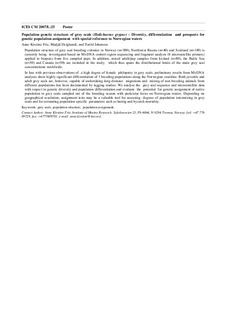Population genetic structure of grey seals (Halichoerus grypus) : Diversity, differentiation and prospects for genetic population assignment with special reference to Norwegian waters
Working paper

Åpne
Permanent lenke
http://hdl.handle.net/11250/103246Utgivelsesdato
2007Metadata
Vis full innførselSamlinger
Originalversjon
This report is not to be quoted without prior consultation with the General Secretary.Sammendrag
Population structure of grey seal breeding colonies in Norway (n=300), Northwest Russia (n=40) and Scotland (n=100) is currently being investigated based on Mt-DNA control region sequencing and fragment analysis (8 microsatellite primers) applied to biopsies from live sampled pups. In addition, mixed adult/pup samples from Iceland (n=80), the Baltic Sea (n=50) and Canada (n=50) are included in the study, which thus spans the distributional limits of the main grey seal concentrations worldwide.
In line with previous observations of a high degree of female philopatry in grey seals, preliminary results from Mt-DNA analyses show highly significant differentiation of 3 breeding populations along the Norwegian coastline. Both juvenile and adult grey seals are, however, capable of undertaking long distance migrations and mixing of non breeding animals from different populations has been documented by tagging studies. We analyse the grey seal sequence and microsatellite data with respect to genetic diversity and population differentiation and evaluate the potential for genetic assignment of native population to grey seals sampled out of the breeding season with particular focus on Norwegian waters. Depending on geographical resolution, assignment tests may be a valuable tool for assessing degrees of population intermixing in grey seals and for estimating population specific parameters such as huntig and bycatch mortality.